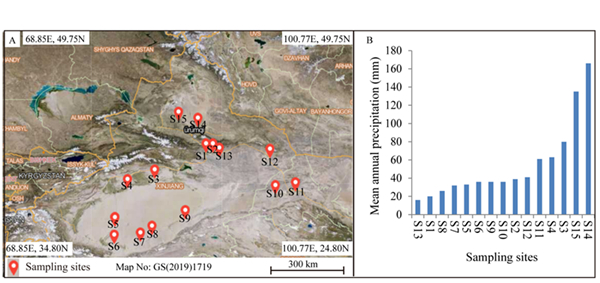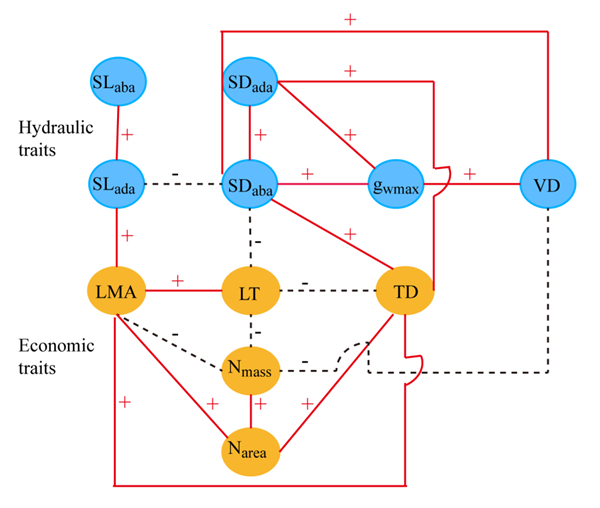Researchers Found the Relationship between Plant Functional Traits of Alhagi sparsifolia Shap and Environment
2021-11-04
Leaf functional traits are highly profiled in ecology because of their closely related to plants' growth and adaptation to environmental stress. The stoichiometry of carbon, nitrogen, and phosphorus (C:N:P) among leaves, stems, and roots reflects trade-offs in plants for acquiring resources and their growth strategy.
A. sparsifolia is widely distributed in arid areas of northwest China and plays an important role in maintaining ecosystem balance in arid areas. It is important to study the stoichiometric characters of A. sparsifolia and its response strategy to environmental variables.
Researchers from Xinjiang Institute of Ecology and Geography, Chinese Academy of Sciences, systematically collected samples of plants and soils including not only aboveground leaves and stems, but also underground roots and soils from a wide range of arid areas during the growing season.
The C,N,P,C:N, C:P, and N:P ratios in leaves, thorns, stems, and roots were derived to explore their relationship as well as their response mechanisms to nutrients and water spanning 1m deep in the soil.
The results showed that the order of N concentration was leaves > thorns > stems > roots, that the concentration of P in the leaves, thorns, and stems was similar, and that their values were higher than those in the roots. First, the C:N ratios in the leaves and stems were significantly positively correlated with the ratio in roots. The C:N ratios in each organ showed a significant relationship with the soil alkali hydrolyzable nitrogen (SAN) above a depth of 60cm. In addition to SAN, soil available phosphorus (SAP) and soil organic carbon (SOC) affect the C:N ratio in the roots.
Second, the C:P and N:P ratios in aboveground organs showed no correlations with the ratios in roots. The C:P and N:P ratios in the leaves and thorns have no relationship with soil nutrients, while the C:P ratio in roots was influenced by SAN and SOC in all soil layers. Finally, the N:P ratios in roots were also affected by nutrients in different soil depths at 0–20 and 60–80cm.
These results illustrate that the roots were more sensitive to soil nutrients than the aboveground parts. This study emphasize that subsurface organs may be more indicative than aboveground organs in studying the response of ecological stoichiometry to environmental factors.
The results are published in Frontiers in Plant Science. Article link: https://doi.org/10.3389/fpls.2021.698961
In addition, this team systematically studied the relationship between economic and hydraulic traits of the leaves of A. sparsifolia on a large scale in arid area of northwest China. And discussed the response mechanism of economic and hydraulic traits to environmental variables.
Results showed that the stomatal density (SD) on both surfaces was coupled with maximum stomatal conductance to water vapor (gwmax) and leaf tissue density (TD). SD on adaxial surface (SDaba) was significantly positively related to vein density (VD) but negatively related to leaf thickness (LT) and stomatal length on adaxial surface (SLada). Nitrogen concentration based on mass (Nmass) was significantly negatively correlated with leaf mass per area (LMA), LT, and VD, whereas nitrogen concentration based on area (Narea) was significantly positively related to LMA and TD. Mean annual precipitation (MAP) contributed the most to the changes in LT and stomatal length (SL). Soil salt contributed the most to TD, SD, and gwmax. Soli nutrients influenced the most of LMA and VD. Mean annual temperature contributed the most to Nmass and Narea.
In conclusion, the economics of leaves coupled with their hydraulic traits provides an economical and efficient strategy to adapt to the harsh environment in hyper-arid regions.
The results are published in Plants. Article link: https://doi.org/10.3390/plants10091867.

Fig. 1 Geographical map showing the locations of the sampling sites used in these studies, and gradient in mean annual precipitation across the distribution of the sites.

Fig. 2 Relationship among C, N, and P in the leaf, thorn, stem, and root organs of A. sparsifolia.

Fig. 3 Network diagram of the correlations among leaf hydraulic and economic traits of A. sparsifolia.
Contact: LIU Jie, Xinjiang Institute of Ecology and Geography
E-mail: liujie@ms.xjb.ac.cn



